Tilaka

Right: A Shaiva Hindu with Tilaka (Tripundra)[2][3]
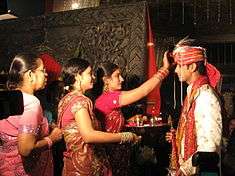
In Hinduism, the Tilaka (Hindi: तिलक) is a mark worn usually on the forehead, sometimes other parts of the body such as neck, hand or chest. Tilaka may be worn on a daily basis or for rites of passage or special religious occasions only, depending on regional customs.
The term also refers to the South Asian ritual of marking someone's forehead with a fragrant paste, such as of sandalwood or vermilion, as a welcome and expression of honor when they arrive.[4]
Description of the tilaka
The tilaka is a mark created by the application of powder or paste on the forehead. Tilakas are vertical markings worn by Vaishnavites. The Vaishnava tilaka consists of a long vertical marking starting from just below the hairline to almost the end of one's nose tip, and they are also known as Urdhva Pundra.[1] It is intercepted in the middle by an elongated U. There may be two marks on the temples as well. This tilaka is traditionally made with sandalwood paste.
The other major tilaka variant is often worn by the followers of Shiva, known by the names of Rudra-tilaka and Tripundra. [5][6] It consists of three horizontal bands across the forehead with a single vertical band or circle in the middle. This is traditionally done with sacred ash from fire sacrifices. This variant is the more ancient of the two and shares many common aspects with similar markings worn across the world.
Shaktas, worshippers of the various forms of the Goddess (Devi) wear a large red dot of kumkum (vermillion or red turmeric) on the forehead.
Significance
Chapter 2 of the Kalagni Rudra Upanishad, a Shaiva tradition text, explains the three lines of a Tilaka as a reminder of various triads: three sacred fires, three syllables in Om, three gunas, three worlds, three types of atman (self), three powers in oneself, first three Vedas, three times of extraction of the Vedic drink Soma.[7][8]
- The first line is equated to Garhapatya (the sacred fire in a household kitchen), the A syllable of Om, the Rajas guna, the earth, the external self, Kriyā – the power of action, the Rigveda, the morning extraction of Soma, and Maheshvara.[7][8]
- The second streak of ash is a reminder of Dakshinagni (the holy fire lighted in the South for ancestors), the sound U of Om, Sattva guna, the atmosphere, the inner self, Iccha – the power of will, the Yajurveda, midday Soma extraction, and Sadashiva.[7][8]
- The third streak is the Ahavaniya (the fire used for Homa), the M syllable in Om, the Tamas guna, Svarga – heaven, the Paramatman – the highest self (the ultimate reality of Brahman), Jnana – the power of knowledge, the Samaveda, Soma extraction at dusk, and Shiva.[7][8]
These lines, states Antonio Rigopoulos, represent Shiva’s threefold power of will (icchāśakti), knowledge (jñānaśakti), and action (kriyāśakti).[9] The Tripuṇḍra described in this and other Shaiva texts also symbolizes Shiva’s trident (triśūla) and the divine triad of Brahmā, Vishnu, and Shiva.[9]
The Vasudeva Upanishad, a Vaishnava tradition text, similarly explains the significance of three vertical lines in Urdhva Pundra Tilaka to be a reminder of Brahma, Vishnu, Shiva; the Vedic scriptures - Rigveda, Yajurveda and Samaveda; three worlds Bhu, Bhuva, Svar; the three syllables of Om - A, U, M; three states of consciousness - awake, dream sleep, deep sleep; three realities - Maya, Brahman and Atman; the three bodies - Sthula, Sukshma, and Karana.[10][11]
Tilaka traditions
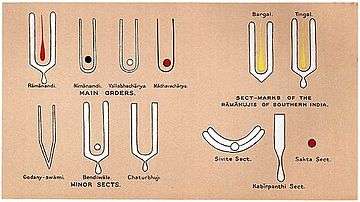
Different Hindu traditions use different materials and shapes to make the tilaka.[12]
- Saivites typically mark their Tilak using vibhuti (ash) in three horizontal lines across the forehead.[1] Along with the three horizontal lines, a bindu of sandalwood paste or a dot of red kumkum in the centre completes the Tilaka (tripundra).[2][3]
- Vaishnavas apply a Tilak with vermillion, clay, sandalwood paste (Chandan), or latter two mixed.[1] They apply the material in two vertical lines, which may be connected at the bottom, forming a simple U shape, often with an additional vertical red marking in the shape of a tulsi leaf inside the U shape. Their tilaka is called the Urdhva Pundra.[1] See also Srivaishnava Urdhva Pundra, the Srivaishnava tilaka.
- Ganapatya use red sandal paste (rakta candana).[13]
- Shaktas use kumkuma, or powdered red turmeric. They draw one vertical line or dot (not to be confused with Bindi used by Indian women from different religions).
- Honorary tilakas (Raja tilaka and Vira tilaka are usually applied as a single vertical red line. Raja tilaka will be used while enthroning kings or inviting prominent personalities. Vira tilaka is used to anoint victors or leaders after a war or a game.
- Swaminarayana tilaka is U-shaped in the middle of forehead along with the red dot in the middle of U (known as chandlo).
Cultural tradition

- Sikhs apply the tilaka as well. The Darshan Darbar devotees apply red tilaka to the forehead. This tilaka is a long red mark veritically applied. Saint Baba Budha ji applied tilaka to the first five Sikh Gurus.[14]
- Jains use Tilaka to mark the forehead of Jaina images with sandalwood paste, during Puja ceremonies.[15]
- Christians in India use Tilaka, both to mark special occasions and during their worship rites.[16]
- Hindus use the Tilaka ceremony, as a mark of honor and welcome to guests, something special or someone special.[4] It may also be used, for same reason, to mark idols at the start of a Puja (worship), to mark a rock or tree before it is cut or removed from its original place for artisan work, or a new piece of property.[4][17]
Types of tilaka
The choice of style is not mandated in Hindu texts, and it is left to the individual and the regional culture, leading to many versions. The known styles include[18] Vijayshree - white tilaka urdhwapundra with a white line in the middle,[18] founded by Swami Balanand of Jaipur; Bendi tilaka - white tilak urdhwapundra with a white round mark in the middle,[19] founded by Swami Ramprasad Acharya of Badasthan Ayodhya; and Chaturbhuji tilaka - white tilak urdhwapundra with the upper portion turned 90 degrees in the opposite direction, no shri in the middle, founded by Narayandasji of Bihar, ascetics of Swarg Dwar of Ayodhya follow it. Sharma has named additional styles as, Vallabh Sampraday Tilak, Sri Tilaka of Rewasa Gaddi, Ramacharandas Tilaka, Srijiwarama ka Tilaka, Sri Janakraja Kishori Sharan Rasik Aliji ka Tilaka, Sri Rupkalajee ka Tilaka, Rupsarasji ka Tilaka, Ramasakheeji ka Tilaka, Kamanendu Mani ka Tilaka, Karunasindhuji ka Tilaka, Swaminarayana Tilaka, Nimbarka ka Tilaka and Madhwa ka Tilaka.[20]
Relationship to bindi
The terms tilaka and bindi overlap somewhat, but are not synonymous.[21] Among the differences:
- A tilaka is always applied with paste or powder, whereas a bindi may be paste or jewel.
- A tilaka is usually applied for religious or spiritual reasons, or to honour a personage, event, or victory. A bindi can signify marriage, or be simply for decorative purposes.
- A bindi is worn only between the eyes, whereas a tilaka can also cover the face or other parts of the body. Tilaka can be applied to twelve parts of the body: head, forehead, neck, both upper-arms, both forearms, chest, both sides of the torso, stomach and shoulder.
- Typically the Bindi is worn only by women, whereas tilaka is worn by both men and women.
Terminology
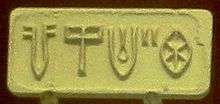
It is also called Tikli or sheether harr in Bengali, tika, or tilakam or tilak in Hindi; Sanskrit: तिलक tilaka; Hindustani pronunciation: [t̪ɪˈlək])[22]
In Nepal, Bihar and other regions, the tilakam is called a tikā/teeka (टिका [ʈɪkaː]), and is a mixture of abir, a red powder, yoghurt, and grains of rice. The most common tikka is red powder applied with the thumb, in a single upward stroke.
Gallery
 Green Tara as Prajnya paramita depicted with tilaka, ca. 11th century.
Green Tara as Prajnya paramita depicted with tilaka, ca. 11th century. Vishnu with Shri Vaisnava tilaka marking.
Vishnu with Shri Vaisnava tilaka marking. Madhvacharya depicted with Angara Akshte tilaka. Tilaka markers are also worn on chest and arms.
Madhvacharya depicted with Angara Akshte tilaka. Tilaka markers are also worn on chest and arms. Gaudiya tilaka.
Gaudiya tilaka.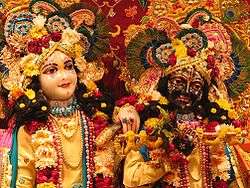 Krishna and Balarama, depicted with Gaudiya tilaka.
Krishna and Balarama, depicted with Gaudiya tilaka._as_Infant_Krishna_-_Walters_543081.jpg) Infant Krishna dipicted with Vaishnavite tilaka, 16th century.
Infant Krishna dipicted with Vaishnavite tilaka, 16th century.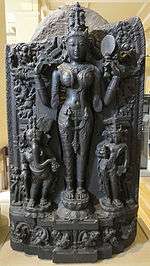 Goddess Lalita dicpicted with tilaka, Pala Dynasty.
Goddess Lalita dicpicted with tilaka, Pala Dynasty. Shri Vaisnava tilaka marking
Shri Vaisnava tilaka marking.jpg) Subramuniyaswami with Tripunda Tilaka
Subramuniyaswami with Tripunda Tilaka Tilaka to welcome in India and Nepal.
Tilaka to welcome in India and Nepal.
See also
- Ash Wednesday - A forehead marking tradition in Christianity
- Bindi - A cosmetic item of decoration in the South Asian culture
- Fascinator - A cosmetic item that is worn near the forehead, and is an alternative to hat
- Third eye
- Tilak (Vaishnava)
- Urdhva Pundra Tilak
- Vibhuti
References
- 1 2 3 4 5 James Lochtefeld (2002), "Urdhvapundra", The Illustrated Encyclopedia of Hinduism, Vol. 2: N–Z, Rosen Publishing, ISBN 978-0823931798, page 724
- 1 2 Deussen, Paul (1997). Sixty Upanishads of the Veda. Motilal Banarsidass Publ. pp. 789–790. ISBN 978-81-208-1467-7.
- 1 2 Gautam Chatterjee (2003), Sacred Hindu Symbols, Abhinav Publications, ISBN 978-8170173977, pages 11, 42, 57-58
- 1 2 3 4 Axel Michaels (2015), Homo Ritualis: Hindu Ritual and Its Significance for Ritual Theory, Oxford University Press, ISBN 978-0190262631, page 100-112, 327
- ↑ Klostermaier, Klaus K. (1984). Mythologies and Philosophies of Salvation in the Theistic Traditions of India. Wilfrid Laurier Univ. Press. pp. 131, 371. ISBN 978-0-88920-158-3.
- ↑ Deussen, Paul (1997). Sixty Upanishads of the Veda. Motilal Banarsidass Publ. pp. 789–790. ISBN 978-81-208-1467-7.
- 1 2 3 4 Deussen 1997, p. 790.
- 1 2 3 4 Nene 1999.
- 1 2 Antonio Rigopoulos (2013), Brill's Encyclopedia of Hinduism, Volume 5, Brill Academic, ISBN 978-9004178960, pages 182-183
- ↑ Sunder Hattangadi (2000), Vasudeva Upanishad, Sama Veda, SanskritDocuments Archives
- ↑ D Dennis Hudson (2008), The Body of God, Oxford University Press, ISBN 978-0195369229, pages 90-95
- ↑ Makhan Jha, Anthropology of ancient Hindu kingdoms: a study in civilizational perspective, Page 126
- ↑ p. 202, note 40. Grimes, John A. Ganapati: Song of the Self. (State University of New York Press: Albany, 1995) ISBN 0-7914-2440-5
- ↑ Purnima Dhavan(2011) "When Sparrows Became Hawks: The Making of the Sikh Warrior Tradition, 1699-1799.", p.36
- ↑ Robert Williams (1998), Jaina Yoga: A Survey of the Mediaeval Śrāvakācāras, Motilal Banarsidass, ISBN 978-8120807754, pages 221-222
- ↑ Robert Eric Frykenberg (2008), Review: Christian Inculturation in India by Paul M. Collins, Journal: Church History (Cambridge University Press), Vol. 77, No. 4, pages 1118-1120
- ↑ E. Washburn Hopkins (1910), Mythological Aspects of Trees and Mountains in the Great Epic, Journal of the American Oriental Society, Vol. 30, No. 4, pages 347-374
- 1 2 Vijay Prakash Sharma, The sadhus and Indian civilisation, page 72
- ↑ Vijay Prakash Sharma, The sadhus and Indian civilisation, page 73
- ↑ Vijay Prakash Sharma, The sadhus and Indian civilisation, page 75
- ↑ personal faith
- ↑ V. S. Apte. A Practical Sanskrit Dictionary. p. 475.
Bibliography
- Deussen, Paul (1997). Sixty Upanishads of the Veda. Motilal Banarsidass Publ. ISBN 978-81-208-1467-7.
- Entwistle, A. W. (1981). Vaishnava tilakas: Sectarian marks worn by worshippers of Vishnu (IAVRI bulletin). International Association of the Vrindaban Research Institute.
- Klostermaier, Klaus K. (1984). Mythologies and Philosophies of Salvation in the Theistic Traditions of India. Wilfrid Laurier Univ. Press. ISBN 978-0-88920-158-3.
- Nene, Roopa (1999). "कालाग्निरुद्रोपनिषत् (Kalagnirudra Upanishad)" (PDF) (in Sanskrit). Retrieved 28 January 2016.
Further reading
- Mittal, Sushil; Thursby, Gene R. (2006). Religions of South Asia: An Introduction. Taylor & Francis, United Kingdom. ISBN 0-415-22390-3. pp. 73.
External links
| Wikimedia Commons has media related to Tilak. |
- How to put on Tilak, Hare Krishna Temple
- Tilaka : Hindu marks on the forehead, Priyabala Shah